In the current SaaS landscape customers have high expectations. If they don’t feel the service is meeting their high demands, they can cancel at any time, and in an industry with so many different software solutions out there, churn can happen at the slightest sign of friction.
For this reason, SaaS and customer success are a match made in heaven. Reactive customer support just won’t cut it anymore; customers need to feel organizations take an active interest in understanding their pain points and proactively trying to solve their problems.
The key differentiator here is reactive vs proactive. Traditional customer support falls into the former while customer success falls squarely in the latter.
The SaaS companies that succeed are those that become respected problem solvers. They recognize that customers stick around when a true rapport is established. This is the essence of customer success. It’s a tricky art to master, but in this article we’re going to help you get to grips with it.
Let’s dive in!
What is customer success in SaaS?
It’s really in the name. Customer success is the processes your company employs to help customers find the value in your product. They help customers find the ‘sticking’ point in your product.
Customers renew when they find utility in your product, meaning your product becomes an indispensable tool for solving problems in their day-to- day lives.
But what does customer success look like in practical terms? It can take many different forms. Here are some of the most common forms:
- Thoughtful onboarding
- Relationship building.
- Training and education
- Customer support
For many smaller SaaS companies, customer success is merely part of the conversion process, but increasingly, it’s becoming its own department and revenue center.
Why does customer success matter in the realm of SaaS?
There are many reasons why customers fail to renew and churn, but all of those reasons are encompassed under one crucial banner: They can’t find the value in your product.
Customer success is like the guiding hand, leading customers to that all important ‘aha’ moment. The role of customer success professionals is a tricky one. CS pros have to effectively showcase the merits of your product while still remaining receptive to the individual needs of the customer.

In simple terms, CS helps companies tighten up their retention and cut churn down to size. Retention is potentially even more important than customer conversion.
It’s cheaper usually, and customers that stick around for a long time become a vital tool for future customer acquisition. In a nutshell; Loyal customers are like living, breathing ads for your product.
The major components of customer success
Customer success will look different depending on the size of your org, your customer profile and the industry you’re operating in. Having said that, there are some essential pillars of customer success you’ll find in most organizations.
Customer onboarding
Think of customer onboarding in SaaS like rolling out the welcome mat for your new users. It's that exciting moment where they're stepping into your software world for the first time, and you want to make sure they feel right at home from the get-go.
Welcome screen
picture this: your new customer signs up, and they're greeted with a friendly "Welcome aboard!" message, complete with their login details and a virtual handshake. Then, it's time to give them the grand tour. You walk them through the coolest features, the must-know shortcuts, and the little tricks that'll make their experience all smooth sailing.
Personalization
Now imagine your product like a luxury hotel. You want your CS department to be like a concierge tailoring the experience just for them. They listen to their needs, their goals, and their quirks, and you sprinkle in suggestions and tips that resonate with their unique situation. It's all about making them feel seen and understood.

Support team
Whether it's a quick chat, an email exchange, or even a good old-fashioned phone call, they're there to lend a helping hand whenever your new user hits a bump in the road. Although customer success has to be proactive, users still have to feel like there’s someone there to answer their vital concerns as they arise.
Essential resources
Video tutorials, knowledge base articles, FAQs – they can be perfect for those customers who prefer their learning to be more self-directed. Customer Success takes the role of guiding them toward those essential resources.
Plan for success
When onboarding a new customer, it’s absolutely essential that you find out what they’re main goals are, then you can set out creating an action plan for them, complete with key milestones along the way.
This way you accomplish two essential tasks, customers see that you’re taking an active interest in their goals. Secondly, you motivate them to achieve their goals and make them more likely to ‘stick’ to your product.
Quarterly reviews
Want to hear a major blunder people make with customer success? They think that once they’ve successfully onboarded a customer it’s job done. But the truth is the work has only just begun. The most pivotal role of CS is to stop customers from leaving once they’ve signed up.
CS pros really prove their salt by checking in on customers regularly to ensure they’re on track with their goals. Sometimes when you lose sight of your objectives, you need a cheerleader in your corner to motivate you. Having that presence in their lives can make all the difference when it comes to customers sticking around.
Playbooks and whitepapers
When it comes to guidance, no two customers are the same. Your customers are individuals, meaning some will prefer that guiding hand, while others will prefer to discover the product on their own.
But this doesn’t mean you neglect them. You can provide them with the map to reach that all-important value moment in the form of documentation. For some, educational documentation can be all the support they need to reach their goals.
Self-service content
In a similar vein, you can provide customers with support in the form of tutorials, how-to-videos and product tours. Some customers aren’t going to want to spend all their time trawling through lengthy documentation. Educational content can be a great way to aid those more visually inclined independent learners.

Creating feedback loops
You want to try and create a continuous feedback loop in place so that customers are empowered to make suggestions wherever they encounter problems. Next you need to follow up with fixes.
A relationship is consolidated when customers can see you’re listening to their concerns and making adjustments in a timely fashion. You should have a mechanism in place for customers to log concerns built into your product. There are many software widget solutions you can use for this.
Metrics you should be tracking for customer success
Like any department within your organization, the best way to see results is always in the hard data. Success needs to be a measurable, quantifiable thing, not just a feeling you have. Here are the best metrics to measure the efficacy of your CS game.
Customer retention
Simply put, it’s the number of customers who see the value in your product and choose to stick around. In SaaS lingo, it's about keeping your users hooked and coming back for more of what you're serving.
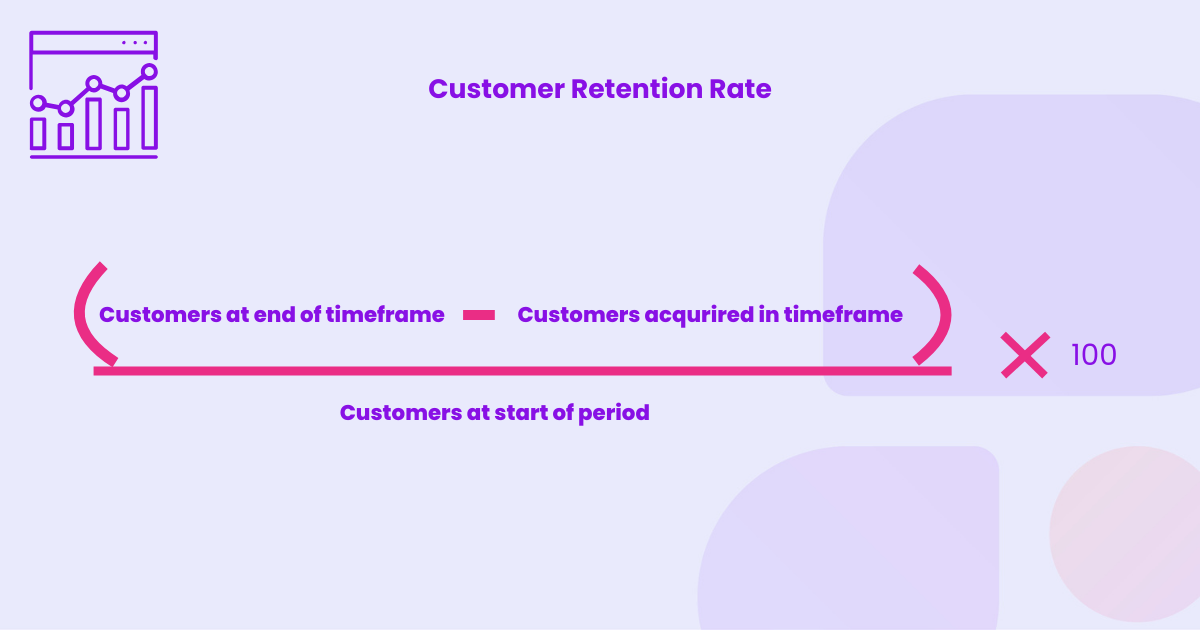
Customer churn
Again, this is very simple. It’s just the number of customers who have said goodbye to your product within the time frame you’re measuring. Churn is something you need to keep a close eye on at all times. By having a firm grasp on who exactly is churning and why, you can tighten up parts of your onboarding process that are allowing customers to fall through the net.
Here’s how to calculate:
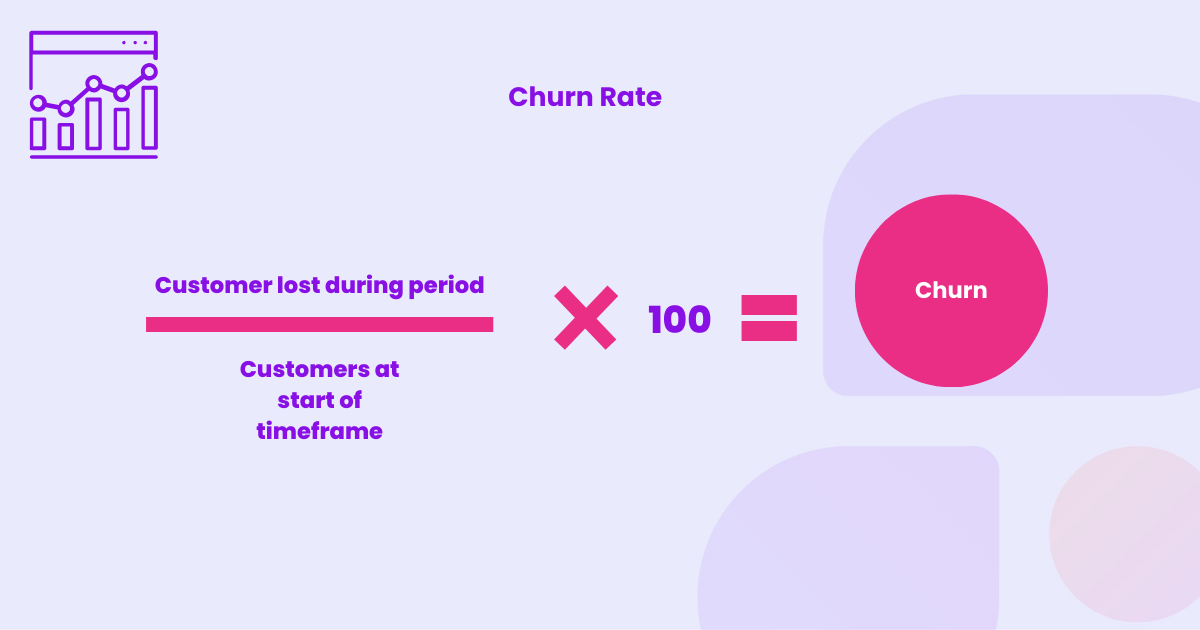
Customer satisfaction score
This is where customers rate tthe experience you’re providing. This way you can spot early warning signs and take steps to strengthen those relationships before it leads to a customer leaving. Often customer feedback can reveal flaws that you wouldn’t have even considered from your own analysis, so make sure you take these insights seriously.
Calculate as follows:
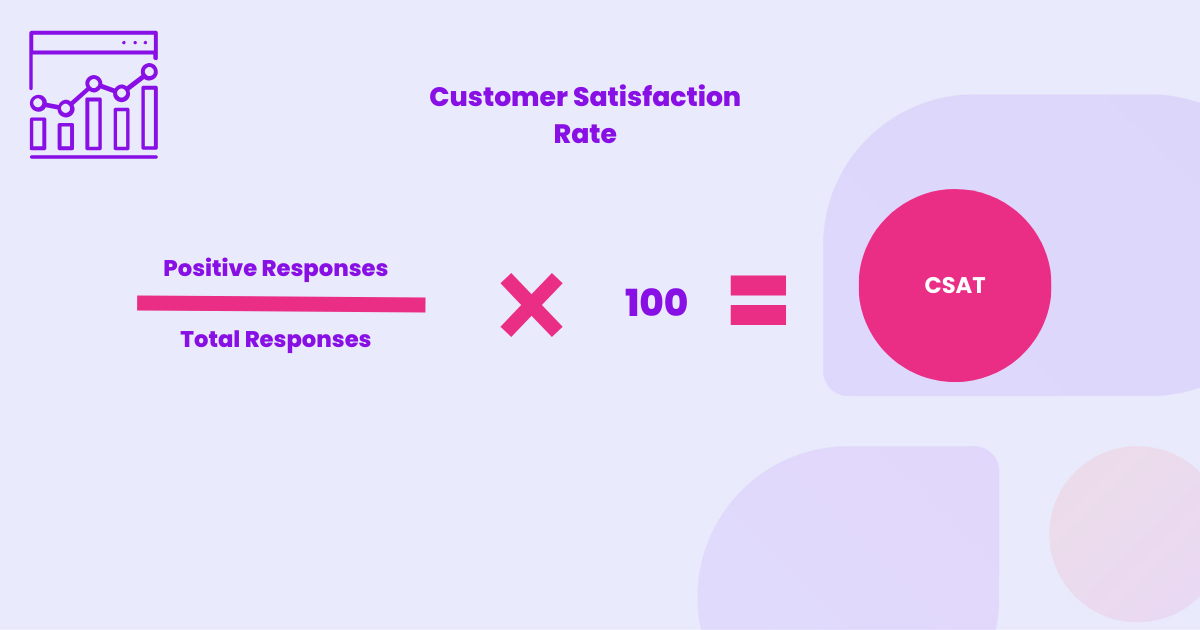
Product adoption
A great way to detect fires before the whole house burns down. If you have a whole host of customers who are simply not using your product very often at all, you can bet it’s going to lead to a pretty devastating mass churn eventually. Keep track of how often customers are using your product and also which features they’re using the most. It’s possible that some customers are simply overlooking the value of certain aspects.
Customer lifetime value
This is the value that customers are bringing to your product during their whole time with your product. An important rule of thumb: you never want your customer lifetime value to be lower than your customer acquisition costs. If this happens it means that it’s costing you more to bring in customers than you’re actually making out of them long term.
To calculate CLTV is as follows:
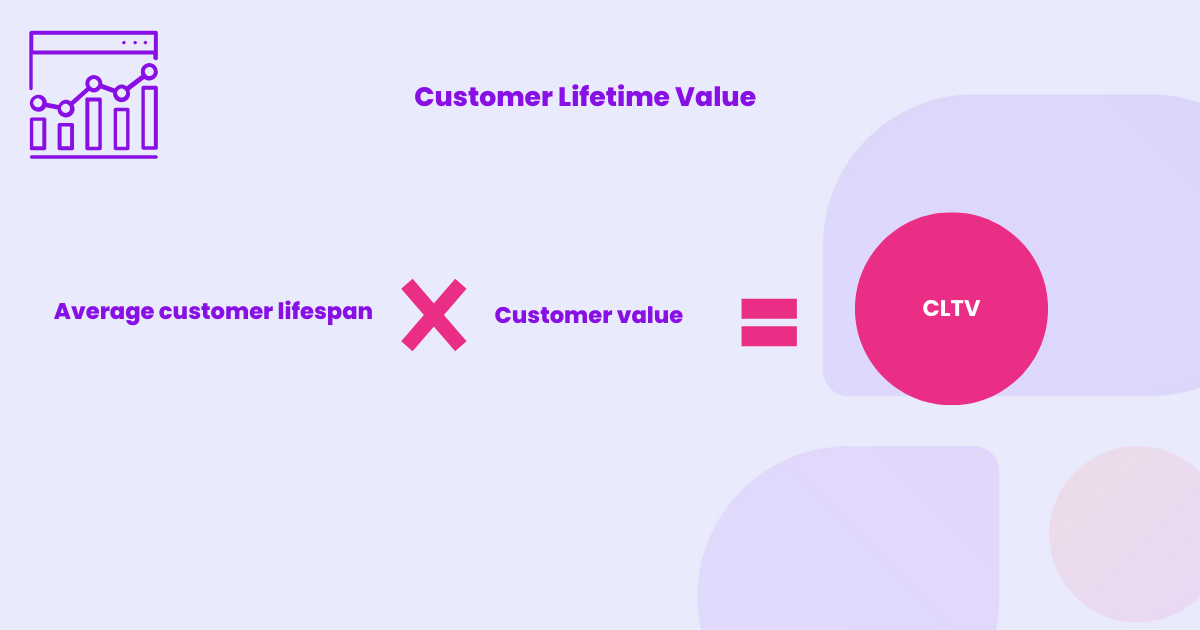
Net revenue retention
Net Revenue Retention (NRR) is a metric used by SaaS companies to measure the effectiveness of their customer success efforts in driving revenue growth from existing customers. It quantifies the revenue retained from existing customers over a specific period, accounting for upgrades, expansions, downgrades, and churn.
Key roles for customer success
Like any function within a SaaS company there are a lot of moving parts coming together in order for everything to run smoothly. Customer Success is no different. It’s a team effort to make it work, and that all comes down to your team structure.
Let’s break down the ideal team structure for a SaaS org right here
VP of customer success
The VP of Customer Success is the captain customer satisfaction ship at a SaaS company. They set the course for success, build a stellar team, and offer support and guidance to your Customer Success Managers (CSMs) when the waters get choppy on important accounts.
Chief customer officer
From support to success, the CCO takes the reins, ensuring our customers' needs are front and center. They're not just another face at the leadership table—they're the voice advocating for customer success in every conversation with product, engineering, and sales teams.
Customer Success manager
Your dedicated customer success manager (or CSM) is really your superhero when it comes to proactively solving customer problems – there to swoop in and save the day before you have a major churn problem on your hands. Their role is to understand and anticipate customer concerns and take steps to reach out and ensure your users have the best possible experience with your product.
At every stage of the customer journey, from that initial onboarding to the coveted advocacy stage, your CSM monitors customer behavior, keeping a hawk eye out for signs of dissatisfaction or disengagement; they then take steps to help customers find that all-important value moment. They also look out for customers who may be primed for upsells and cross sells. Simply put, they’re on the front lines when it comes to averting disaster in the form of customer churn.
Technical specialist
As we’ve stressed in this article, it’s essential for CSMs in SaaS to have a certain level of Technical acumen, and this should enable them to address more fundamental customer concerns, but CSMs aren’t hired solely for their tech savvy, they’re hired for that essential human touch that allows them to connect with users and feel like they’re needs are met and their voices heard.
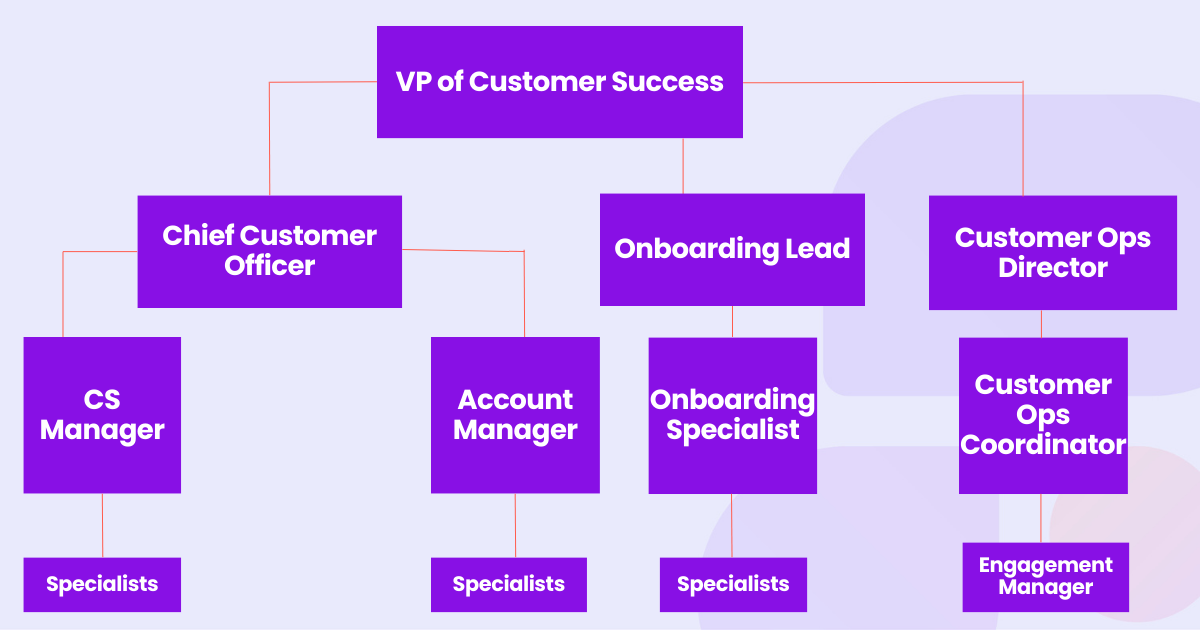
But there are always going to be more complex problems that require a greater level of technical expertise. And this is when it’s essential for your CSMs to have a solid working relationship with your technical wizards, ensuring that those more complicated issues are passed on and resolved in a timely manner.
Technical specialists uphold the integrity of your software infrastructure, ensuring that customers have a smooth, glitch-free experience getting acquainted with your product. A big part of customer success is quite simply this: Ensuring customers have a delightful experience with your product. And for this to happen, the integrity of your infrastructure needs to be given that TLC regularly.
SaaS onboarding specialist
First impressions matter. This is true of a first date, your first day on a new job, and yep, you guessed it, it matters for the first interactions your customers have with your product. How you handle the onboarding flow is going to have a significant impact on the customer journey further down the line, increasing the chances of customer loyalty.
The role of the SaaS onboarding specialist is to ensure users get that tailored, personalized experience. This is another aspect of customer success which takes it beyond conventional customer support. The goal is to ensure you’re understanding each individual customer’s unique pain points from the get go. And this starts at the onboarding stage. One way to achieve this is by helping customers to outline their unique goals and milestones early on.
Customer Success analyst in SaaS
In order to provide customers with a tailored experience, customer success professionals need data and insights. Customer success is always going to need fine-tuning, and with the right data analysis you can identify parts of the customer journey where customers are falling through the cracks. It can also reveal which features are providing the most value to customers.
SaaS account managers
SaaS account managers serve as the strategic champions within customer success teams, prioritizing account expansion and retention. Their role involves fostering and strengthening customer relationships, pinpointing fresh business prospects, and consistently demonstrating the ongoing value of the SaaS investment to customers.
Customer education specialist
As a customer success specialist the role isn’t just to swoop in and rescue customers from churning, it's also to empower customers in their own discovery and learning. The main job in this role is to provide customers with the tools to get the most out of your product. It’s important to stress that some customers will prefer a more hands-on approach from the company, while others value independence, they only need you to provide them with the tools to succeed with the product.
Customer feedback specialist
Custom feedback is essential if you want to iterate on the things you’re doing right and optimize the things you’re not doing right. Retention is often less costly than acquisition, and collecting feedback is the way to ensure customers are happy with the service you’re providing and make your retention rates soar. The goal of any SaaS company should be to seek to establish a continuous feedback loop with your customers, so that you're always iterating an optimizing your product according customer expectations and needs.
Essential customer success software tools
In order to succeed in your customer success strategy you need to take advantage of the latest software solutions. This will enable you to keep a close eye on customer relationships, customer progress and keep customer data organized.
Customer relationship management software (CRM)
This is like your one-stop hub for everything you need to help customers succeed, encompassing sales, customer service and support. The whole history of your customer interactions and support tickets will be provided here, granting you a birds eye view of your customer journey. A SaaS business needs to have a holistic view of the customer journey and the latest CRM provides this.
Support ticketing software
There needs to be a process in place by which customers can log complaints and have them addressed, especially since as your company grows the concerns are going to multiply. Concerns that are resolved or unresolved need to be categorized as such. Without this, concerns are going to fall through the cracks, customers are unsatisfied, and you’re going to end up with a sky high churn rate.
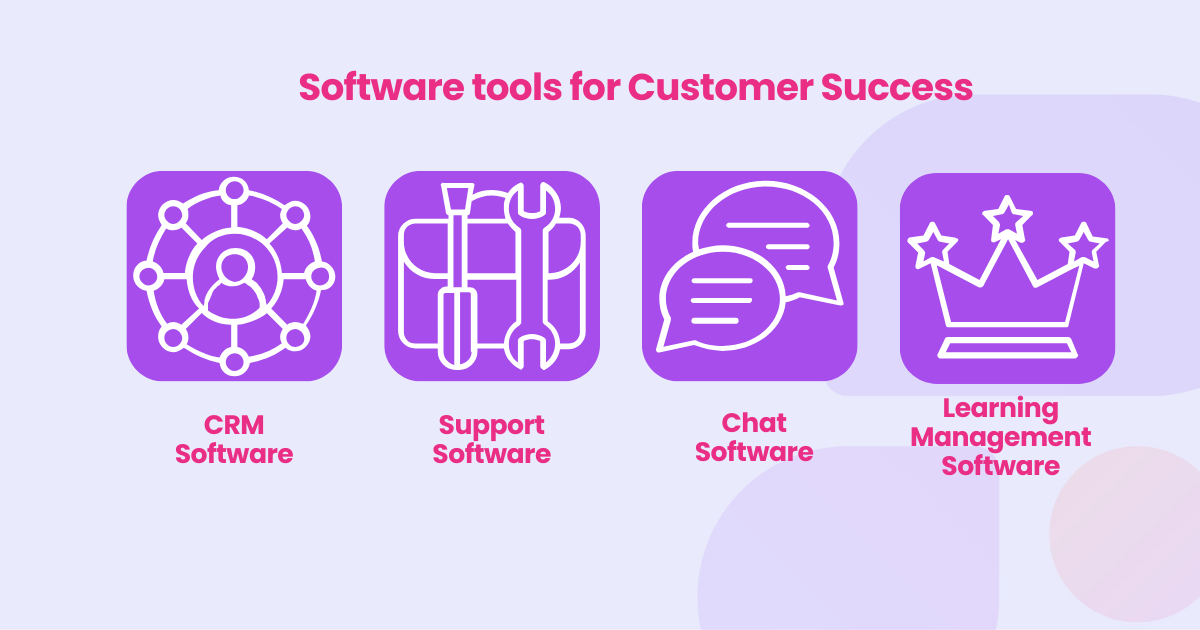
Chat software
This one really doesn’t need much explanation. Nowadays customers expect a higher level of support, and the SaaS companies that are able to resolve customer problems quickly are the ones that are going to rise to the top. Chat software allows you to keep all customer communications in one place and reply to them in a timely manner.
Learning management software (LMS)
Remember we mentioned how some customers prefer the self-guided approach? Well a solid LMS platform is the way to ensure that those customers are accommodated in their customer journey. By giving customers the tools they need to succeed you’re showing that you have a vested interest in their professional goals, and that really is the essence of customer success. It’s not just about getting those sweet customer conversions, it’s about ensuring your product has a major impact on them, making it an indispensable part of their day-to-day life.
Wrapping up
Customer success is an exciting function and it’s only growing. If you utilize it right it can be a vital tool in both your customer acquisition and retention arsenal. Just remember that it’s all about proactive customer care.
The ultimate goal of any SaaS org is to anticipate the needs of customers before they even show up. Do the work when it comes to researching the market and have a firm idea of what your customers are going to need from a SaaS product. From that point on, you’ll have a CS function that delights your users and keeps them around for a long time to come.
Enjoyed these insights? Why not check out exclusive insights from some of the leading minds in SaaS right here? 👇



